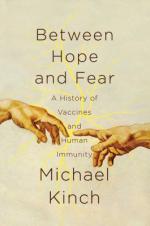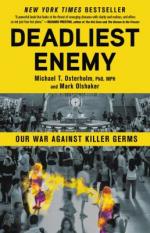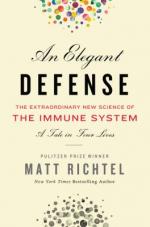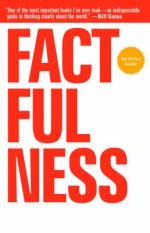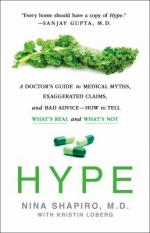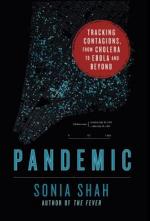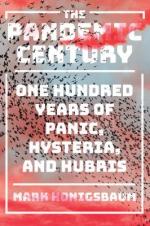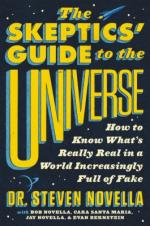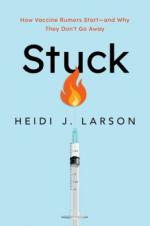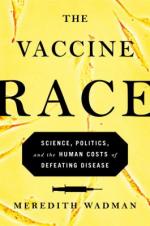March 5, 2021 | sobczakd
As the COVID-19 crisis continues and we wait for the vaccine distribution to expand, Booklist a magazine by the American Library Association, has published a list of books focusing on the science behind vaccinations and how misinformation can spread as fast as a deadly virus. These books help separate fact from fiction.
A smart and compelling examination of the science of immunity, the public policy implications of vaccine denial, and the real-world outcomes of failing to vaccinate. If you have a child in school, you may have heard stories of long-dormant diseases suddenly reappearing--cases of measles, mumps, rubella, and whooping cough cropping up everywhere from elementary schools to Ivy League universities because a select group of parents refuse to vaccinate their children. Between Hope and Fear tells the remarkable story of vaccine-preventable infectious diseases and their social and political implications. While detailing the history of vaccine invention, Kinch reveals the ominous reality that our victories against vaccine-preventable diseases are not permanent--and could easily be undone. In the tradition of John Barry's The Great Influenza and Siddhartha Mukherjee's The Emperor of All Maladies, Between Hope and Fear relates the remarkable intersection of science, technology and disease that has helped eradicate many of the deadliest plagues known to man.
Unlike natural disasters, whose destruction is concentrated in a limited area over a period of days, and illnesses, which have devastating effects but are limited to individuals and their families, infectious disease has the terrifying power to disrupt everyday life on a global scale, overwhelming public and private resources and bringing trade and transportation to a grinding halt. In today's world, it's easier than ever to move people, animals, and materials around the planet, but the same advances that make modern infrastructure so efficient have made epidemics and even pandemics nearly inevitable. And as outbreaks of COVID-19, Ebola, MERS, and Zika have demonstrated, we are woefully underprepared to deal with the fallout. So what can -- and must -- we do in order to protect ourselves from mankind's deadliest enemy? Drawing on the latest medical science, case studies, policy research, and hard-earned epidemiological lessons, Deadliest Enemy explores the resources and programs we need to develop if we are to keep ourselves safe from infectious disease. The authors show how we could wake up to a reality in which many antibiotics no longer cure, bioterror is a certainty, and the threat of a disastrous influenza or coronavirus pandemic looms ever larger. Only by understanding the challenges we face can we prevent the unthinkable from becoming the inevitable.
The Pulitzer Prize-winning New York Times journalist "explicates for the lay reader the intricate biology of our immune system" (Jerome Groopman, MD, New York Review of Books)
New York Times science reporter Matt Richtel's An Elegant Defense illuminates the human immune system as never before, uniquely entwining intimate patient stories with science's centuries-long quest to unlock the mysteries of sickness and health. The immune system is our body's essential defense network, a guardian vigilantly fighting viruses and illness, healing wounds, maintaining order and balance, and keeping us alive. Its legion of microscopic foot soldiers--from T cells to "natural killers"--patrols our body, linked by a nearly instantaneous communications grid. It has been honed by evolution over millennia to face an almost infinite array of threats. For all its astonishing complexity, however, the immune system can be easily compromised by fatigue, stress, toxins, advanced age, and poor nutrition--hallmarks of modern life--and even by excessive hygiene. Paradoxically, it is a fragile wonder weapon that can turn on our own bodies with startling results, leading today to epidemic levels of autoimmune disorders. Richtel effortlessly guides readers on a scientific detective tale winding from the Black Plague to twentieth-century breakthroughs in vaccination and antibiotics, to the cutting-edge laboratories that are revolutionizing immunology--perhaps the most extraordinary and consequential medical story of our time. The foundation that Richtel builds makes accessible revelations about cancer immunotherapy, the microbiome, and autoimmune treatments that are changing millions of lives. An Elegant Defense also captures in vivid detail how these powerful therapies, along with our behavior and environment, interact with the immune system, often for the good but always on a razor's edge that can throw this remarkable system out of balance. Drawing on his groundbreaking reporting for the New York Times and based on extensive new interviews with dozens of world-renowned scientists (including Dr. Anthony Fauci, director of the National Institute of Allergy and Infectious Diseases), Matt Richtel has produced a landmark book, equally an investigation into the deepest riddles of survival and a profoundly human tale that is movingly brought to life through the eyes of his four main characters, each of whom illuminates an essential facet of our "elegant defense."
When asked simple questions about global trends--what percentage of the world's population live in poverty; why the world's population is increasing; how many girls finish school--we systematically get the answers wrong. So wrong that a chimpanzee choosing answers at random will consistently outguess teachers, journalists, Nobel laureates, and investment bankers. In Factfulness, Professor of International Health and global TED phenomenon Hans Rosling, together with his two long-time collaborators, Anna and Ola, offers a radical new explanation of why this happens. They reveal the ten instincts that distort our perspective--from our tendency to divide the world into two camps (usually some version of us and them) to the way we consume media (where fear rules) to how we perceive progress (believing that most things are getting worse). Our problem is that we don't know what we don't know, and even our guesses are informed by unconscious and predictable biases. It turns out that the world, for all its imperfections, is in a much better state than we might think. That doesn't mean there aren't real concerns. But when we worry about everything all the time instead of embracing a worldview based on facts, we can lose our ability to focus on the things that threaten us most.
There is a lot of misinformation thrown around these days, especially online. Headlines tell us to do this, not that---all in the name of living longer, better, thinner, younger. In Hype, Dr. Nina Shapiro distinguishes between the falsehoods and the evidence-backed truth. In her work at Harvard and UCLA, with more than twenty years of experience in both clinical and academic medicine, she helps patients make important health decisions everyday. She's bringing those lessons to life here with a blend of science and personal stories to discuss her dramatic new definition of "a healthy life." Hype covers everything from exercise to supplements, diets to detoxes, alternative medicine to vaccines, and medical testing to media coverage. Shapiro tackles popular misconceptions such as toxic sugar and the importance of drinking eight glasses of water a day. She provides simple solutions anyone can implement, such as worrying less about buying products labeled organic or natural, and more about skipping vaccines, buying into weight-loss fads, and thinking you can treat cancer through diet alone. This book is as much for single individuals in the prime of their lives as it is for parents with young children and the elderly.
Over the past fifty years, more than three hundred infectious diseases have either emerged or reemerged, appearing in places where they've never before been seen. Years before the sudden arrival of COVID-19, ninety percent of epidemiologists predicted that one of them would cause a deadly pandemic sometime in the next two generations. It might be Ebola, avian flu, a drug-resistant superbug, or something completely new, like the novel virus the world is confronting today. While it was impossible to predict the emergence of SARS-CoV-2--and it remains impossible to predict which pathogen will cause the next global outbreak--by unraveling the stories of pandemics past we can begin to better understand our own future, and to prepare for what it holds in store. In Pandemic: Tracking Contagions, from Cholera to Ebola and Beyond, Sonia Shah interweaves history, original reportage, and personal narrative to explore the origins of epidemics, drawing parallels between cholera--one of history's most deadly and disruptive pandemic-causing pathogens--and the new diseases that stalk humankind today. She tracks each stage of cholera's dramatic journey, from its emergence in the South Asian hinterlands as a harmless microbe to its rapid dispersal across the nineteenth-century world, all the way to its latest beachhead in Haiti. Along the way she reports on the pathogens now following in cholera's footsteps, from the MRSA bacterium that besieges her own family to the never-before-seen killers coming out of China's wet markets, the surgical wards of New Delhi, and the suburban backyards of the East Coast. Delving into the convoluted science, strange politics, and checkered history of one of the world's deadliest diseases, Pandemic is a work of epidemiological history like no other, with urgent lessons for our own time.
Ever since the 1918 Spanish influenza pandemic, scientists have dreamed of preventing catastrophic outbreaks of infectious disease. Yet despite a century of medical progress, viral and bacterial disasters continue to take us by surprise, inciting panic and dominating news cycles. From the Spanish flu to the 1924 outbreak of pneumonic plague in Los Angeles to the 1930 "parrot fever" pandemic, through the more recent SARS, Ebola, and Zika epidemics, the last one hundred years have been marked by a succession of unanticipated pandemic alarms. In The Pandemic Century, a lively account of scares both infamous and less known, Mark Honigsbaum combines reportage with the history of science and medical sociology to artfully reconstruct epidemiological mysteries and the ecology of infectious diseases. We meet dedicated disease detectives, obstructive or incompetent public health officials, and brilliant scientists often blinded by their own knowledge of bacteria and viruses. We also see how fear of disease often exacerbates racial, religious, and ethnic tensions--even though, as the epidemiologists Malik Peiris and Yi Guan write, "'nature' remains the greatest bioterrorist threat of all." Like man-eating sharks, predatory pathogens are always present in nature, waiting to strike; when one is seemingly vanquished, others appear in its place. These pandemics remind us of the limits of scientific knowledge, as well as the role that human behavior and technologies play in the emergence and spread of microbial diseases.
It is intimidating to realize that we live in a world overflowing with misinformation, bias, myths, deception, and flawed knowledge. There really are no ultimate authority figures-no one has the secret, and there is no place to look up the definitive answers to our questions (not even Google). Luckily, The Skeptic's Guide to the Universe is your map through this maze of modern life. Here Dr. Steven Novella-along with Bob Novella, Cara Santa Maria, Jay Novella, and Evan Bernstein-will explain the tenets of skeptical thinking and debunk some of the biggest scientific myths, fallacies, and conspiracy theories-from anti-vaccines to homeopathy, UFO sightings to N- rays. You'll learn the difference between science and pseudoscience, essential critical thinking skills, ways to discuss conspiracy theories with that crazy co- worker of yours, and how to combat sloppy reasoning, bad arguments, and superstitious thinking.
Vaccine reluctance and refusal are no longer limited to the margins of society. Debates around vaccines' necessity -- along with questions around their side effects -- have gone mainstream, blending with geopolitical conflicts, political campaigns, celebrity causes, and "natural" lifestyles to win a growing number of hearts and minds. Today's anti-vaccine positions find audiences where they've never existed previously. Stuck examines how the issues surrounding vaccine hesitancy are, more than anything, about people feeling left out of the conversation. A new dialogue is long overdue, one that addresses the many types of vaccine hesitancy and the social factors that perpetuate them. To do this, Stuck provides a clear-eyed examination of the social vectors that transmit vaccine rumors, their manifestations around the globe, and how these individual threads are all connected.
Until the late 1960s, tens of thousands of American children suffered crippling birth defects if their mothers had been exposed to rubella, popularly known as German measles, while pregnant; there was no vaccine and little understanding of how the disease devastated fetuses. In June 1962, a young biologist in Philadelphia, using tissue extracted from an aborted fetus from Sweden, produced safe, clean cells that allowed the creation of vaccines against rubella and other common childhood diseases. Two years later, in the midst of a devastating German measles epidemic, his colleague developed the vaccine that would one day wipe out homegrown rubella. The rubella vaccine and others made with those fetal cells have protected more than 150 million people in the United States, the vast majority of them preschoolers. The new cells and the method of making them also led to vaccines that have protected billions of people around the world from polio, rabies, chicken pox, measles, hepatitis A, shingles and adenovirus.
Meredith Wadman's masterful account recovers not only the science of this urgent race, but also the political roadblocks that nearly stopped the scientists. She describes the terrible dilemmas of pregnant women exposed to German measles and recounts testing on infants, prisoners, orphans, and the intellectually disabled, which was common in the era. These events take place at the dawn of the battle over using human fetal tissue in research, during the arrival of big commerce in campus labs, and as huge changes take place in the laws and practices governing who "owns" research cells and the profits made from biological inventions. It is also the story of yet one more unrecognized woman whose cells have been used to save countless lives.
